Explore the ideal time to travel to Bangkok! Uncover when the weather, attractions, and cultural events align for your perfect Thai adventure.
Did you know that Bangkok, the vibrant capital city of Thailand, welcomes more than 20 million tourists each year? Its blend of bustling markets, grand temples, and exquisite cuisine make it one of Asia’s most visited cities. But when exactly is the best time to visit Bangkok? Let’s delve into an in-depth Bangkok travel guide that helps you determine your ideal time to travel to Bangkok.
Key Takeaways
- Bangkok experiences its mildest weather conditions from November to March.
- Due to high demand during this peak season, travelers are advised to book accommodations and flights early.
- Bangkok’s monsoon season spans from May to late September or early November, which might impact outdoor activities.
- Festivals such as the Golden Mount Temple Fair and Loy Krathong provide authentic Thai experiences.
- Culturally rich temple visits and shopping excursions are excellent indoor activities during the rainy season.
- Tourist influx from November to March affects hotel pricing and flight availability, making it essential to plan ahead.
Understanding Bangkok’s Climate and Seasons
Revered as a must-visit destination for globetrotters, Bangkok enchants with its vivid culture, bustling markets, ornate shrines, and certainly, its unique weather patterns. Fathom the different seasons in Bangkok, the varying weather in Bangkok, and the formidable monsoon season in Bangkok to seamlessly navigate your travels in this fascinating city and fully partake in its cornucopia of experiences.
Overview of Weather Patterns
An integral part of planning your visit to this diverse metropolis involves comprehending its tropical climate, which creates distinct seasonal variances. Two pronounced seasons exist – a relatively dry season from November to February, followed by a rainy season spanning the rest of the year. However, it’s worth noting that rain showers in the city are usually brief, although heavy, allowing for ample sunny periods in between.
Temperature and Humidity Variations
Undeniably, the temperature and humidity in Bangkok impact tourist experiences quite significantly. Despite the city’s reputation for high temperatures, typically ranging between 77-95°F (25-35°C), it does see considerable fluctuations across different seasons. The city’s geographical location near the equator, however, ensures that temperatures rarely drop below 68°F (20°C), providing warm weather to its residents and visitors year-round.
Monsoon Season and its Impact
Between May and October, Bangkok experiences its monsoon season, generally characterized by afternoon showers and occasional thunderstorms. This period is associated with high humidity levels, escalating heat perception and occasionally impacting outdoor activities, but also breathes life into the city, boosting its greenery and charm. Interestingly, visiting during the monsoon season presents its own perks – reduced crowd sizes, discounted accommodation rates, and optimal conditions for indoor pursuits.
The Best Time to Visit Bangkok for Pleasant Weather
If tranquil and manageable weather conditions are the aim of your travel to the bustling city, the best months to visit Bangkok undoubtedly fall between November and March. It is at this time when temperate climatic conditions balance the prevailing humidity, offering a gratifying atmosphere for tourists.
Navigating Bangkok’s Temperature Highs and Lows
During these months, Bangkok experiences daytime temperatures hovering around the high 80s to low 90s (26°C – 34°C). As the sun dips, the mercury too takes a plunge with overnight lows in the mid-70s (around 24°C). Notably, this nighttime temperature threshold can drop to the 60s (15°C – 20°C) from December to January, making a leisurely stroll along the Chao Phraya river or a nighttime market exploration seem less daunting.
Benefits of Traveling in the Cooler Months
Unsurprisingly, these cooler months charm travelers with their relative lack of precipitation and reduced humidity levels. This fosters a much more convenient and bearable environment for outdoor activities such as sightseeing, street food exploration, or even stretching a sun lounger on the beaches near Bangkok. During this period, the city flourishes under the sun without overwhelming its visitors, revealing its true vibrancy and charm.
Importance of Booking in Advance During Peak Season
However, this favorable weather pattern also signals the onset of the peak travel season in Bangkok. The augmented tourist volumes result in heightened demand for accommodation and travel bookings. Therefore, it is imperative for potential travelers to secure their bookings months in advance to evade the eleventh-hour scramble and surge pricing.
In conclusion, determining when to visit Bangkok requires careful analysis of one’s weather preferences and travel aspirations. An equally essential factor in this decision-making process is the consideration of travel costs and availability, predominantly impacted by the city’s peak travel season.
| Month | High Temperature | Low Temperature | Average Precipitation | Tourist Volume |
|---|---|---|---|---|
| November | 32°C | 24°C | Low | High |
| December | 31°C | 20°C | Low | High |
| January | 31°C | 20°C | Low | High |
| February | 33°C | 24°C | Low | High |
| March | 34°C | 26°C | Low | High |
Traveling to Bangkok During Off-Peak Season
Visiting Southeast Asia’s vivid city, Bangkok during its off-peak season might sound counterintuitive; nonetheless, there’s a lot more to it than meets the eye. Spanning from July to October, the off-peak season offers a unique perspective on the area’s tropical charm, despite being marked by sweltering, humid weather and unpredictable rainfall. Most importantly, this period can be leveraged to avail some excellent travel deals in Bangkok.
In the off-peak season, service providers, eager to maintain a steady inflow of tourists, generally propose significant discounts. The potential savings can stretch your travel budget, allowing you to enjoy a more extensive, in-depth exploration of Bangkok.
- Hotel Accommodations: The abundance of accommodation options in Bangkok during this time creates a perfect scenario for travelers, often flaunting generous discounts on room rates. From boutique hotels in the old town to luxury resorts along the river, the decreased demand brings more affordability.
- Aquatic Activities: Given the season’s heat, water-based activities and attractions see a surge in their popularity. Whether it’s river cruises, kite-surfing, or a relaxing day at a waterpark, these activities usually have lower rates during off-peak periods.
While the outdoor weather may not be the most pleasant, indoor ventures come to the rescue. The city’s renowned shopping malls, fascinating aquariums, and spiritual temple tours all become attractive options. They permit you to partake in Bangkok’s vibrant culture and lifestyle, without bearing the brunt of the weather.
Hence, if you are intensively budget-minded or prefer avoiding crowds, the off-peak season in Bangkok might just be the hidden gem you’ve been looking for. With attractive travel deals and a plethora of engaging activities, your Bangkok travel experience stands to be uniquely rewarding and memorable.
Tips for Experiencing Bangkok’s Famous Festivals
Amid your travels to Bangkok, immersing in the city’s vibrant festivals is an essential, unmatched way to experience the local culture first hand. These events, which occur year-round, serve as an authentic mirror reflecting the city’s rich cultural tapestry and are certain to leave you with lifelong impressions of Bangkok’s compelling allure.
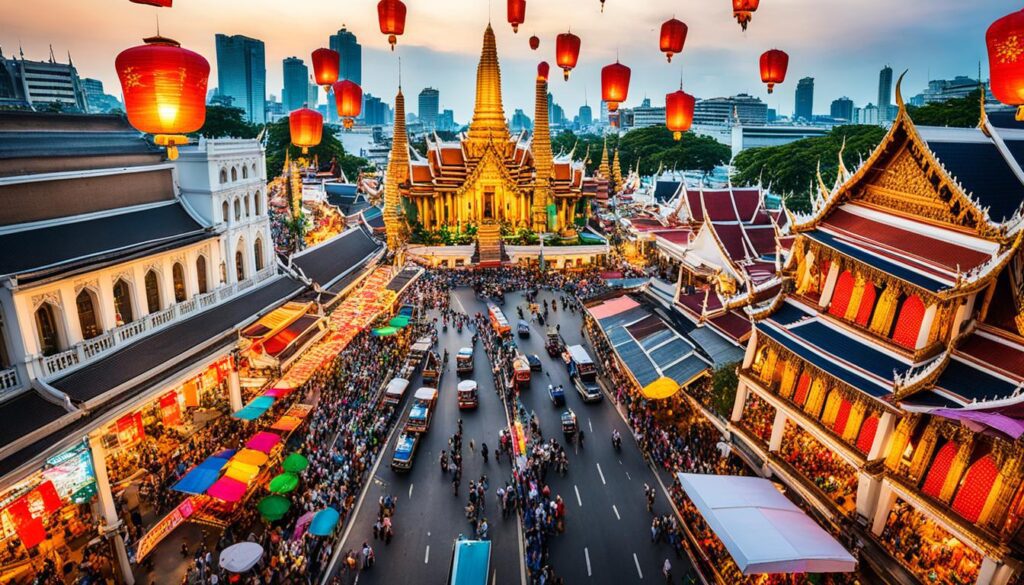
Annual Highlights: Loy Krathong and Songkran
Noteworthy mentions include the Golden Mount Temple Fair and Loy Krathong in November, celebrating the water goddess, where thousands of people send intricately decorated baskets afloat in rivers and canals under the glow of a moonlit sky. Another highly anticipated event is Songkran, the traditional Thai New Year celebrated in April, renowned worldwide for its exuberant water fights that take over the streets.
Peak Festival Seasons and Travel Suggestions
Other events like the Chinese New Year in January, Makha Bucha in February, and both the International Festival of Dance and Music and the Moon Festival in September offer quintessential Thai experiences. It is important to remember, however, that these peak festival times, while incredibly rewarding, require strategic planning to maximize enjoyment and minimizes the inconvenience of overcrowded locales.
- Opt for arriving a day or two early at your festival destination to secure a good spot and acclimate.
- Book your accommodations and transportation in advance to avoid inflated prices and availability issues.
- Learn about the festival’s traditions and respectful practices to ensure an enriching and respectful experience.
With the right planning, attending Bangkok’s cultural events like Loy Krathong and Songkran provide an unparalleled insight into the city’s heart and soul, promising undeniably memorable experiences that add warmth and color to your Bangkok journey.
Bangkok’s Peak Tourist Volumes vs. Costs
One of the most intriguing aspects of planning a trip to Bangkok is managing the costs, especially during the months where the tourist traffic surges. It’s an undeniable fact that the fluctuation of costs—whether for flights or hotel accommodations—rides heavily on the volume of tourists.
Analyzing Tourist Traffic Fluctuations
The influx of tourists in Bangkok skyrockets from November through March, as the pleasant weather during these months lures travelers. It’s during these weather-induced peaks that one might experience somewhat skyrocketed costs in hotel pricing and limited flight availability. A deeper understanding of these traffic fluctuations can lead you to carve out less expensive travel periods and seize some excellent deals.
How Seasonality Affects Hotel and Flight Prices
Seasonal variations play a pivotal role in dictating hotel and flight costs in Bangkok. Should you aim to score better deals, targeting the rainy season could prove beneficial. During these months, the reduced tourist activity translates into lower pricing, as demand takes a backseat. Specifically, the mid-November to mid-December timeframe emerges prominently when it comes to shopping. Mirroring the off-season trend, prices during these months remain competitive compared to the January to March tourist influx, as shopkeepers prepare for the high season. Choosing the right time to visit can significantly impact your overall travel experience and budget.
Cultural Considerations When Planning Your Bangkok Trip
When exploring the bustling cityscape of Bangkok, a travel guide for Bangkok can certainly provide a well-rounded introduction. However, to truly acquaint one’s self with the city’s charming character, delving into Bangkok’s celebrated cultural events become indefensible. An appreciation of Thai customs and traditions allow international voyagers an opportunity to fully embrace the collective spirit of the metropolis, enriching their Bangkok adventure manifold.
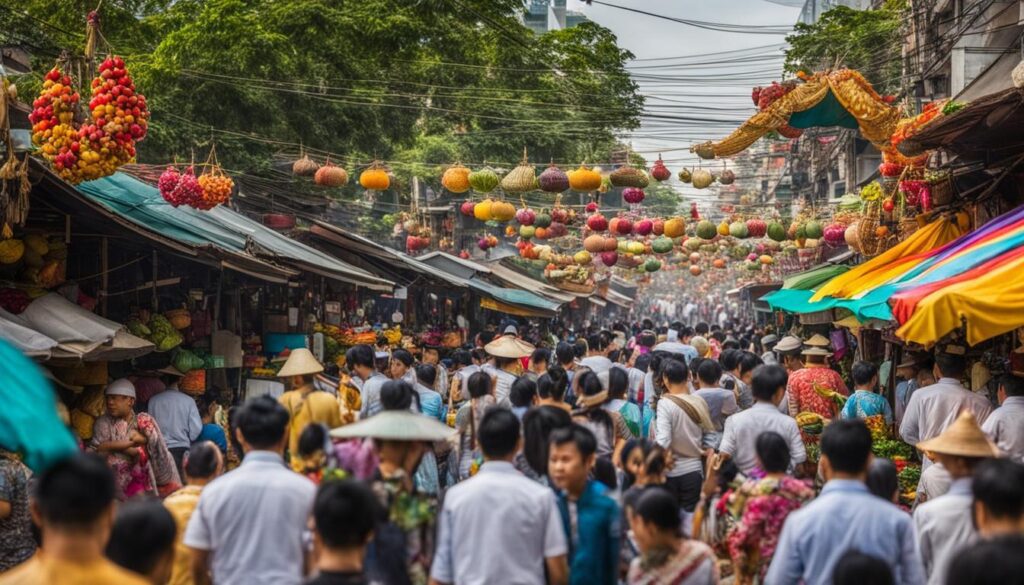
Songkran in April, the traditional Thai New Year, is a water festival that invites fun-soaked merrymaking and symbolic purification rituals. Ranks of locals and tourists enthusiastically participate in water fights, signifying washing off negativities, worries, and bad luck to welcome the New Year with purified spirits.
| Event | Month | Description |
|---|---|---|
| Songkran | April | Traditional Thai New Year’s water festival celebrated with water fights, parades, and dances. |
| Visakha Bucha | May | A religious event observed with great reverence, commemorating the birth, enlightenment, and passing of Buddha. |
In May, Visakha Bucha is commemorated with utmost reverence. This religious event marks the birth, enlightenment, and passing into nirvana of Buddha. Temples across Bangkok light up with candle processions as locals and visitors alike come together to honor this significant Buddhist occasion with fluttering prayer flags and spiritual rituals.
Experiencing these cultural facets of Bangkok imparts travelers with an enriching exploration that transcends beyond typical tourism, providing a deeper understanding of local customs, religious beliefs, and communal celebrations. Planning your Bangkok trip with these cultural events in focus can certainly add memorable vibrance, authentic interaction, and ever-lasting impressions of your Thai journey.
Above all, whether savoring the spicy street food, wading through the eclectic markets, or immersing in the dynamic cultural events, remember to always approach each experience with respect and open-mindedness, in true Thai spirit. Travel, after all, is not just about visiting a place, but truly living it.
Discovering Indoor Activities During Rainy Season in Bangkok
When the heavens open and frequent showers drape the bustling city of Bangkok, a variety of indoor attractions offer an exciting respite from the rain. In fact, these indoor activities not only offer shelter from the rain but also present wonderful opportunities to delve deeper into the city’s eternally rich culture and modern developments. This makes a multitude of Bangkok rainy season activities popular among tourists and locals alike.
Shopping and Entertainment Opportunities
Undeniably, shopping is an activity that never goes out of season in Bangkok, come rain or sun. The city houses an impressive array of shopping venues, ranging from local markets to plush malls. Malls such as Central World and Siam Paragon, are not only a shopper’s paradise but also offer a raft of entertainment options including movie theaters, ice-skating rinks, and gourmet eateries. Take a look at our Bangkok shopping guide below offering a detailed insight into various shopping and entertainment complexes that you can explore during the rainy season in Bangkok.
| Shopping Complex | Location | Notable Features |
|---|---|---|
| Central World | Ratchaprasong Intersection | One of the largest malls in Southeast Asia, featuring over 500 shops and scores of entertainment facilities |
| Siam Paragon | Siam Square | A luxurious shopping mall housing many high-end brands, gourmet restaurants, and an aquarium |
| MBK Center | Phayathai Road | Renowned for its collection of mobile phones and accessories, photography equipment, and fashionable clothing |
Exploring Museums and Temples When It’s Wet Outside
While Bangkok is known for its mesmerizing outdoor activities, its indoor attractions are equally alluring. Besides shopping, visiting Bangkok temples and museums can be a wonderful experience during the rainy season. The city’s historical richness can be witnessed in its numerous museums. From the enthralling National Museum and the Museum of Siam to fascinating religious edifices like Wat Phra Kaew (Temple of the Emerald Buddha) and Wat Arun (Temple of Dawn), there’s plenty to explore to satisfy your cultural curiosity. Check the table below for some must-visit indoor attractions during rainy days in Bangkok.
| Museum/Temple | Location | Notable Features |
|---|---|---|
| National Museum | Na Phra That Road | Displays artifacts and Thai artwork spanning centuries |
| Museum of Siam | Sanamchai Road | Offers an insight into the history of Bangkok through various interactive exhibits |
| Wat Phra Kaew | Phra Nakhon | One of the most sacred temples in Thailand, housing the Emerald Buddha |
| Wat Arun | Wat Arun, Bangkok Yai | Known for its stunning prang (Khmer-style tower) and intricate floral mosaics |
Experiencing Bangkok during the rainy season comes with its unique charms. While the city’s landscape may be cloaked under wet weather, the opportunities to explore indoor attractions like vibrant shopping complexes and spiritually-rich temples remain endless. It’s all about making the most of the rains and relishing what the city has to offer, maintaining a spirit of adventure that remains unhampered regardless of the weather.
Conclusion
The ideal time to travel to Bangkok is from November to March, characterized by its balmy weather. A particular sweet spot for visitors lies between mid-November and mid-December, promising less congestion and excellent opportunities for shopping without the hefty price tags of peak season.
Regardless of when you choose to visit, each season presents its unique appeals. The hotter months come with enticing discounts—the city’s energetic spirit remains thriving, but at reduced costs on accommodation and activities. These months prove that you don’t need to break the bank to enjoy your Bangkok travel journey.
On the other hand, the cooler months reveal the city’s festive wonders, offering a vibrant kaleidoscope of cultural and traditional experiences. Tourists can witness the splendor of Loy Krathong or marvel at the grandeur of the Golden Mount Temple Fair.
In conclusion, any time could potentially be the best time to visit Bangkok. The key lies in balancing your weather preferences with desired activities, events, and explorations. With the right planning and expectations, your Bangkok trip could be an unforgettable adventure.
FAQ
What is the best time to visit Bangkok?
The best time to visit Bangkok is between November and March when the city experiences its mildest weather. But, it’s essential to book accommodations and flights in advance due to high tourist demand.
How is the climate in Bangkok?
Bangkok has a tropical climate with varying weather patterns throughout the year. The driest months with the least humidity are from November to March, while the hottest and rainiest months are from April to October.
When is the monsoon season in Bangkok, and how does it impact travel?
The monsoon season in Bangkok typically spans from May to late September or early November. It features high rainfall and increased humidity, which can impact outdoor activities.
When is the peak season in Bangkok?
The peak season in Bangkok runs from November to March when the weather is at its best for travel. Accommodation and flights should ideally be booked months in advance due to the increase in tourist volumes.
What is the off-peak season like in Bangkok?
The off-peak season between July and October, characterized by sweltering and humid weather, offers economic benefits to travelers with affordable hotel accommodations and discounts on aquatics activities.
Can you give some tips for experiencing Bangkok’s famous festivals?
Notably, visit the Golden Mount Temple Fair and Loy Krathong in November, the Chinese New Year in January, Makha Bucha in February, International Festival of Dance and Music, and the Moon Festival in September. However, these peak festival times demand strategic planning to avoid crowded locales.
How does seasonality affect hotel and flight prices in Bangkok?
Tourist traffic surges from November through March during the peak travel season impacting hotel pricing and flight availability. To score deals, planning travel during the rainy season could be beneficial due to reduced tourism activity.
Are there any cultural considerations when planning a trip to Bangkok?
Engaging with local events like Songkran in April or Visakha Bucha in May can provide an authentic insight into Thai traditions. Culturally sensitive travelers could find these experiences invaluably enriching, connecting with locals and understanding customs.
What indoor activities are recommended during the rainy season in Bangkok?
When rain showers envelop Bangkok, visitors can engage in indoor activities. From city’s shopping malls, entertainment complexes to iconic temples such as Wat Phra Kaew and Wat Arun, the rainy season need not dampen travel spirits.


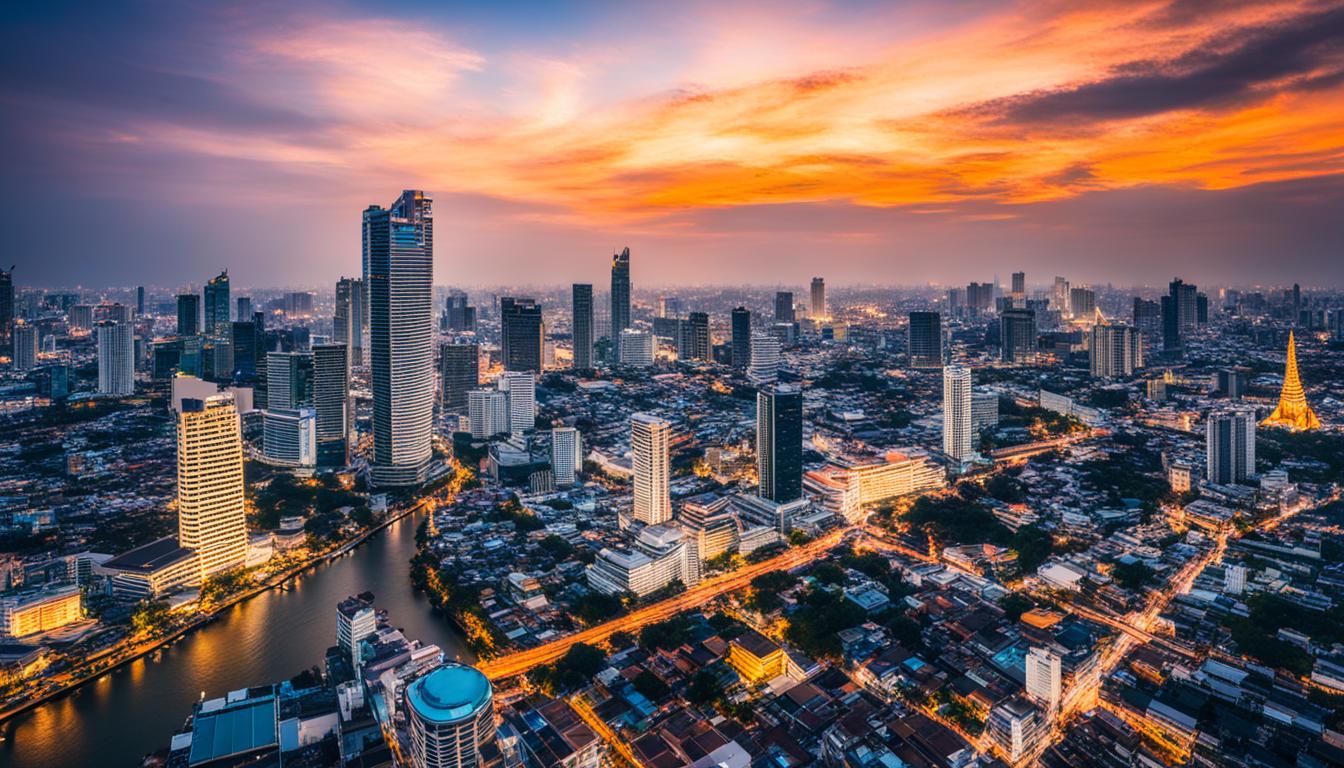
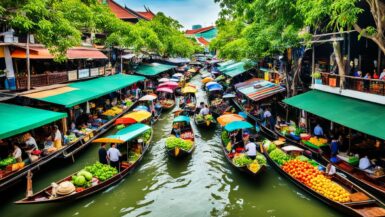
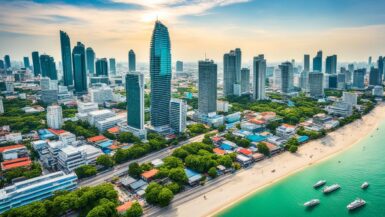
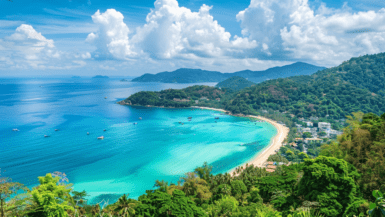
Leave a reply